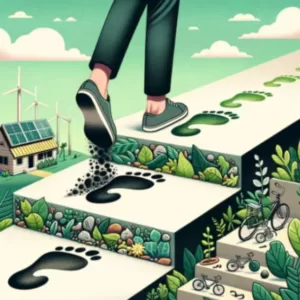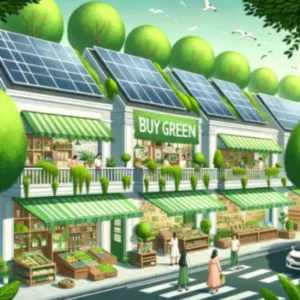
Imagine a world where climate change is no longer a crisis. Polar ice caps remain frozen. Cities aren’t inundated by rising seas. Extreme weather no longer threatens lives and livelihoods. This vision may seem optimistic, but it can become our reality if each of us commits to reducing our carbon footprints through simple, daily choices. Small actions multiply to drive great change. This article provides 10 easy, practical steps anyone can take to tread more lightly on our fragile planet.
Our carbon footprints measure the amount of greenhouse gases we generate through our activities. Greenhouse gases like carbon dioxide and methane trap heat in the atmosphere, causing global warming. The consequences are already severe – melting glaciers, shifting seasons, ferocious storms, and extinctions. The future will be even bleaker if carbon emissions continue unabated.
The major sources of carbon pollution are burning oil, coal and natural gas for energy, transportation, forestry and food production. While big systemic changes like transitioning to renewable energy are crucial, individual choices also make an enormous difference. By altering habits around home energy, diet, transportation, shopping and waste, each of us can shrink our footprints. Small steps multiply to yield huge benefits for the planet.
Change One – Eat Less Meat and Dairy

Livestock farming generates copious amounts of planet-warming gases. Cows and sheep produce massive amounts of methane when digesting their food. Clearing forests to create pastures and growing vast tracts of monoculture crops like corn and soy for animal feed increases carbon in the atmosphere. Producing just one hamburger patty generates the same emissions as driving a small car 20 miles!
So, try having meatless Mondays. Expand your palate by exploring vegetarian recipes with legumes, nuts and eggs for protein. If you can’t give up meat entirely, reduce portions and choose chicken or pork over beef. Cutting dairy like milk and cheese also helps, since dairy farming contributes significant emissions. With plant-based milks and cheeses available, making the switch is easy.
Change Two – Reduce Food Waste
One-third of all food produced gets discarded, ending up in methane-spewing landfills. Growing, processing, transporting and refrigerating food requires immense amounts of energy and water. When perfectly edible food gets tossed, those resources are wasted along with the food. Food waste globally causes 8% of human-caused greenhouse gas emissions!
Combat waste by only buying what you’ll actually eat. Plan meals using foods on hand. Store leftovers to eat later. Compost scraps instead of trashing them. Eat imperfect but still tasty produce that would otherwise get thrown out. Push back against excessive packaging, which leads to food spoilage. Be an informed, responsible shopper and consumer.
Change Three – Eat Local in Season
The average American meal contains ingredients from at least five countries. Transporting produce, grains and meats over long distances burns fuel and releases carbon. However, seasonal food grown nearby minimizes transportation miles and emissions.
Visit farmer’s markets or join a CSA (community supported agriculture) program to source fresher, local food. Consult guides listing fruits and vegetables in season where you live. Try growing some of your own produce if you can. Preserve summer’s bounty by canning, pickling or freezing for enjoyment in winter. Not only will local, seasonal eating shrink your carbon footprint, but you’ll get the most flavorful and nutritious foods.
Change Four – Walk, Bike or Take Public Transit

Vector representation of an urban landscape where a road is occupied solely by Electric Vehicles. The sky is clear, and there are trees lining the sidewalk, emphasizing a green, eco-friendly environment.
Vehicles burning gasoline and diesel emit nearly one-fifth of global carbon pollution. In the US, transportation creates the largest share of greenhouse gases. Driving less reduces emissions and smog. For short trips under three miles, consider walking or biking rather than driving. You’ll get exercise and fresh air too!
Taking public transportation like buses, light rail and subways is also vastly more sustainable than solo car travel. Advocate in your community for improving and expanding public transit options. Try carpooling for longer commutes and errands. Driving with others divides the emissions, providing a greener choice.
Change Five – Maintain Vehicles for Efficiency
If driving is a must, keeping your vehicle well-maintained will maximize mileage and minimize emissions. Simple habits like checking tire pressure, changing air filters, replacing worn spark plugs, and regular oil changes improve fuel efficiency. Fixing drips, dragging brakes, sticking gas pedals and poor alignment also boost efficiency, saving gas and cutting carbon.
When purchasing a new or used car, focus on fuel economy. Generally, smaller vehicles with 4-cylinder engines emit less than larger SUVs and trucks. Electric and hybrid models further reduce environmental impact. Be mindful of your driving habits too – going the speed limit, accelerating gently and avoiding excessive idling conserves fuel.
Change Six – Fly Less When Practical
Air travel leaves an enormous carbon footprint. When a plane is airborne, it dumps at least a pound of carbon dioxide into the air for every mile each passenger flies. Long haul flights are the worst climate offenders.
Of course, many journeys require flying. But try exploring staycation destinations closer to home. Attend conferences virtually if possible. For essential trips, fly nonstop on efficient aircraft and pack light to cut weight and fuel burn. Consider offsetting flight emissions by purchasing carbon credits supporting renewable energy or reforestation. With some forethought, flying less can cut huge amounts of carbon.
Change Seven – Use LED Lights

Small switches around your home can make a difference. Incandescent bulbs are hugely inefficient – 90% of their energy gets wasted as heat, not light. Switching to LEDs cuts electricity use by 75%. They last years longer too. LEDs are now just a couple dollars per bulb, paying for themselves in energy savings in less than a year.
Install dimmers, motion sensors, and timers to further cut waste. Turn off lights when not needed and maximize natural daylight. Unplugging unused electronics and appliances also reduces phantom load wasted when plugged in. Simple adjustments cut home energy use, reducing your carbon impact.
Change Eight – Adjust Thermostats
Heating and cooling accounts for around half of household energy usage. By tweaking your thermostat settings, you can conserve energy and shrink your carbon footprint without sacrificing comfort.
In winter, set the thermostat to 68 F (20 C) while awake and 60 F (16 C) while asleep or away. Put on a sweater and cozy socks to stay warm. In summer, let the home naturally warm to 78 F (26 C) and use fans to feel cooler. Drawing blinds, using smart vents, and keeping exterior doors shut will also help maintain comfortable temps. Programmable and smart thermostats make temp control easy. With small thermostat tweaks, you’ll stay cozy while reducing emissions.
Change Nine – Seal Air Leaks and Insulate
Heated or cooled air leaking out wastes energy and drives up carbon pollution. Prevent leaks by sealing windows, adding weatherstripping around doors, sealing ductwork, and even using caulk or spray foam to fill holes where cables or pipes penetrate walls. Stopping air leaks can reduce home energy bills by 10-20%!
Likewise, adding insulation slows heat transfer, saving energy. Insulate attics, basements and crawl spaces that lack adequate insulation. Use insulating gaskets behind electrical outlets on exterior walls. Pulling curtains over windows provides additional insulation. Draft-proofing your home traps comfortable air inside, reducing the carbon emitted to heat or cool it.
Change Ten – Buy Less and Buy Green

Rethink your purchasing to minimize waste and emissions. Analyze if an item is really needed or just desired. Repair rather than replace items when practical. Buy quality products built to last. Shopping at thrift and consignment stores extends useful life of goods already produced.
When buying new, select sustainably created items. Support businesses practicing ethical manufacturing with green materials and processes. Choose locally made goods to reduce transport miles. Buy in bulk to reduce packaging. Purchasing fewer but well-made items reduces carbon impacts from manufacturing and waste.
Change Eleven – Borrow, Share and Thrift
Own less by borrowing instead. Take advantage of libraries for books and movies rather than purchasing everything. Seek out tool libraries to borrow equipment for home projects. Hardware stores rent larger equipment.
Share resources and space. Co-own infrequently used tools or recreational gear with friends. Share rides to school, events or errands. Use public sharing services for bicycles or scooters. Invite someone to share your extra room or vacant guest house, known as “accessory dwelling units“. Shared use maximizes value from resources already available.
Purchase secondhand when possible. Shop yard sales, thrift stores and online exchanges. Upcycling re-purposes discarded materials into new uses, like making furniture from pallets. Repairing gives new life to broken items headed for landfills. Buying reused and making do with less shrinks your environmental impact.
Change Twelve – Recycle and Compost
Recycling reduces carbon emissions by limiting the need to extract new raw materials. Recycling aluminum saves 95% of the energy required to produce it from ore. Recycled paper, plastic, steel and glass all reduce carbon pollution significantly compared to creating new materials.

Sort your recyclables into proper bins. Avoid single-use plastics that are rarely recycled. Support and participate in local recycling programs. Upcycle non-recyclable plastics into new products.
Compost all food scraps and yard waste rather than trashing them. Composting provides free fertilizer for gardens without methane-producing landfill rot. Many communities offer free compost bins along with pickup services for compost materials. Keep compost bins convenient in kitchens, yards and gardens to divert waste easily.
In Conclusion
Small daily steps to shrink your carbon footprint can drive significant climate change progress when multiplied by 7 billion people. Begin implementing three new sustainable practices in your own life. Explore more ways to reduce your impact. Discuss these ideas with family and friends, inspiring others. Local efforts spur global momentum. Through our individual choices and actions, each of us can whisper – rather than shout – our presence on this fragile planet. With care and commitment, we move closer to a future where climate change is no longer a looming crisis but a problem successfully solved by united human ingenuity.


